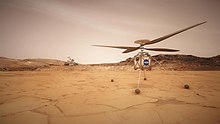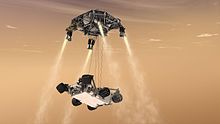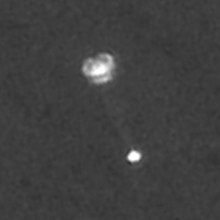Mars aircraft


A Mars aircraft is a vehicle for flying in the atmosphere of Mars. So far, Mars lander entry, descent, and landing systems have passed through the atmosphere. Aircraft may provide in situ measurements of the atmosphere of Mars, as well as additional observations over extended areas. A long-term goal is to develop piloted Mars aircraft.[3][4]
Compared to Earth, the air is thinner at the surface (with pressure less than 1% of Earth's at sea level) but the gravity is lower (less than 40%).[5][4] Mars air, consisting mostly of CO2 gas, is over 50% denser than Earth air adjusted to equal pressure.[4]
History
In 1918, the Danish science fiction film Himmelskibet (aka A Trip to Mars) included an aerospace craft called "Excelsior" for a manned trip to Mars.[6]
Before the start of Mars exploration with spacecraft, the density of Mars' atmosphere was suspected to be higher than was later measured to be, leading engineers to think that winged flight would be much easier than it actually is. In his "Mars Project" ("Das Marsproject") concept,[7] Wernher von Braun proposed winged vehicles for landing human missions on Mars.[4]
The first detailed Mars lander contracted by NASA was to Ford/Philco Aeronutronic in the early 1960s, which was for a lifting body design for the lander; this is when some of best estimates for the Mars atmosphere were significantly denser that revealed by the Mariner IV measurements in July 1965.[8] The lander had a tub-shaped lifting body with winglets, and was one of the first detailed designs for Mars lander although it would not be able to fly in the revised figures for the Mars atmospheric conditions.[9] The Aeronutronic Mars lifting-body lander design was based on Mars atmosphere of mostly nitrogen about 10% of Earth.[10]
The July 1965 marked a shift away from lifting body and winged glider style Mars landers to ballistic entry gumdrop style landers.[11]
In the 1970s the Mini-Sniffer aircraft were made in several versions so it could also operate in an all-CO2 environment.[1] The Mini-Sniffer could run without oxygen by using hydrazine, and the design was considered for sampling the atmosphere of Mars.[12] The airplane had a large propeller to be effective in the thin air and many flights of various configurations were made between 1975 and 1982.[13] A winged rover design was proposed in the 1970s, to cover more area than the stationary Viking landers.[4] There was a proposal by NASA in the 1990s for a Mars airplane to fly on Mars by the anniversary of the Wright Brothers's first flight, in the "Faster, Better, Cheaper" era;[4] and the ARES Mars airplane proposal was selected as a Mars Scout Program candidate, but not selected for flight.
In 2015, a Mars aircraft was considered as an option in the re-boot of the Japanese MELOS mission.[14] One early design proposed a wing-span of 1.2m, a mass of 2.1 kg, and with the following mission profile:[14] During the landing phase of the surface element of MELOS, the aircraft would be released at an altitude of 5 km then fly 4 minutes, covering 25 horizontal km.[14]
Airplanes
Prototype Mars planes have flown at close to 30 km (about 98 thousand feet) altitude on Earth (in roughly half of the average air pressure at Mars surface),[15] and tested expandable wings that cure in ultraviolet light.[16] For flight in Mars' atmosphere, the Reynolds number would be very low compared to flight in Earth's atmosphere.[5] Valles Marineris was targeted for an unmanned aircraft flight and by Mars' gliders.[17][4] Gliders could carry more scientific instrumentation, but cover less area.[4] Hydrazine has been proposed as a fuel for Mars aircraft.[4] At one point, NASA was developing plans for a wok-sized airplane "micromission", which would piggyback on a separate Mars bound payload.[4] Mach 1 on Mars can be about 240 meters per second (537 mph) while it is about 332 m/s (743 mph) on Earth.[18]
The Daedalus proposal in the canceled Mars Scout program designed a Mars glider that would fly over 400 km along the Coprates Chasma[19]

Proposed Mars Airplane concepts include:
- ARES (Aerial Regional-scale Environmental Survey)[20]
- MAGE (Mars Airborne Geophysical Explorer)[17]
- AME (Airplane for Mars Exploration)[15]
- MATADOR (Mars Advanced Technology Airplane for Deployment, Operations and Recovery)[15]
- Sky-Sailor, solar powered airplane with micro-robots[21]
- Kitty Hawk, multi-glider mission[17]
- Daedalus, glider with 400+ km range[22] (Mars Scout 2011 proposal)[23]
- ARMaDA, "Advanced Reconnaissance Martian Deployable Aircraft"[24]
- MAREA, "Martial Aerial Research Euroavia Airplane"[24]
- Prandtl-M[25] (Preliminary Research Aerodynamic Design to Land on Mars)[26]
- NASA Mini-Sniffer, considered for sampling the atmosphere of Mars, tested running on hydrazine (air independent).[27]
Balloons
Balloons may provide an alternative to parachutes, allowing for a soft landing.[28] A balloon could allow a lander to take off and land at a new site.[28] Two types of balloon technology are super-pressure and Montgolfiere.[28] The super-pressure balloons try to contain the pressure caused by heating to maintain altitude.[28] The Montgolfiere would use heated Martian air to create lift.[28] An example of concept for Mars balloon was the Mars Geoscience Aerobot.[29] Some work has been done to develop extremely thin, flexible solar cells that could allow a balloon's skin itself to generate power from the Sun.[30]
Rotorcraft

In 2002, a paper was published suggesting autonomous robotic helicopters for Mars exploration, possible for the Mars Scout Program.[31] A number of advantages of a viable rotorcraft design were noted, including the ability to pass over difficult Mars terrain yet still visit multiple sites in situ.[32] The short hop made by Lunar Surveyor 6 in 1967 was noted as example of hopping to visit another site.[33]
A small scout drone, launching from a Mars rover has been in development in the late 2010s, including $23 million USD for a helicopter demonstration in 2018.[34][35] The program for the Mars Helicopter Scout possibly for the Mars 2020 rover would high resolution downward-looking camera for navigation, landing, and science surveying of the terrain, and a communication system to relay data back to the rover.[36]
Other aircraft and airborne devices



- Mars rotorcraft[37]
- Hypersonic gliders were proposed by Wernher von Braun.[4]
- Various parachutes have been the main air-borne device
- Rocket-sustained flight as in the case of retro-rockets have also been a part of landing systems
- Aeroshells from various spacecraft
- A rocket powered hopper (e.g. Mars Geyser Hopper)
- Mars Helicopter Scout (MHS), a mini-helicopter to scout routes for a rover[38]
Parachutes


Virtual
Mars Express HRSC and MRO's HiRISE data can provide virtual Mars flyovers by draping surface pictures over 3D terrain models.[39][40][41]
See also
- Aerobraking
- Aerobot
- Mars atmospheric entry
- List of missions to Mars
- Mars flyby
- Dragonfly (spacecraft), a rotorcraft for Saturn's moon Titan
References
- ^ a b [1]
- ^ [2]
- ^ Oliver Morton – MarsAir (January 2000) – Air & Space magazine[permanent dead link]
- ^ a b c d e f g h i j k Oliver Morton – MarsAir How to build the first extraterrestrial airplane. – NASA Quest
- ^ a b Development and Flight Testing of a UAV with Inflatable-Rigidizable Wings – University of Kentucky Archived 2010-06-17 at the Wayback Machine
- ^ [3]
- ^ von Braun, Wernher (1991) [1952]. The Mars Project (2nd ed.). University of Illinois Press. ISBN 978-0-252-06227-8.
- ^ "The Road to Mars..." Air & Space Magazine. Retrieved 2018-07-19.
- ^ "The Road to Mars..." Air & Space Magazine. Retrieved 2018-07-19.
- ^ "The Road to Mars..." Air & Space Magazine. Retrieved 2018-07-19.
- ^ [4]
- ^ "NASA Dryden Mini-Sniffer Photo Collection". www.dfrc.nasa.gov. Retrieved 2018-01-21.
- ^ [5]
- ^ a b c [6]
- ^ a b c Mars Airplane – Ames Research Center
- ^ [http://www.engr.uky.edu/~idea /wiki/lib/exe/fetch.php?id%3Dpeople%253Ajel%253A00pubs%26cache%3Dcache%26media%3Dpublications:0503_ieee_simpson.pdf BIG BLUE: High-Altitude UAV Demonstrator of Mars Airplane Technology]
- ^ a b c John F. McGowan, Ph.D. – Wings on Mars (December 3, 1999)
- ^ Mars Science Laboratory Mission Profile
- ^ [7]
- ^ Ares Mars Airplane website Archived 2010-03-25 at the Wayback Machine
- ^ Sky-Sailor
- ^ Daedalus (April 2005)[permanent dead link]
- ^ [8]
- ^ a b Euroavia students design Martian aerial vehicle (ESA)
- ^ Could This Become the First Mars Airplane? NASA June 2015
- ^ "Flying the Friendly Martian Skies: NASA to Test Mars Airplane Prototype". AmericaSpace. 2015-07-01. Retrieved 2018-07-19.
- ^ [9]
- ^ a b c d e NASA – Mars Balloons
- ^ Mars Balloon Trajectory Model for Mars Geoscience Aerobot Development (1997)
- ^ http://www.lpi.usra.edu/meetings/marsconcepts2012/pdf/4307.pdf
- ^ Young, Larry; Aiken, E.W.; Gulick, Virginia; Mancinelli, Rocco; Briggs, Geoffrey (2002-02-01). "Rotorcraft as Mars Scouts". 1: 1–378 vol.1. doi:10.1109/AERO.2002.1036856. ISBN 078037231X.
{{cite journal}}: Cite journal requires|journal=(help) - ^ Young, Larry; Aiken, E.W.; Gulick, Virginia; Mancinelli, Rocco; Briggs, Geoffrey (2002-02-01). "Rotorcraft as Mars Scouts". 1: 1–378 vol.1. doi:10.1109/AERO.2002.1036856. ISBN 078037231X.
{{cite journal}}: Cite journal requires|journal=(help) - ^ Young, Larry; Aiken, E.W.; Gulick, Virginia; Mancinelli, Rocco; Briggs, Geoffrey (2002-02-01). "Rotorcraft as Mars Scouts". 1: 1–378 vol.1. doi:10.1109/AERO.2002.1036856. ISBN 078037231X.
{{cite journal}}: Cite journal requires|journal=(help) - ^ NASA Mars exploration efforts turn to operating existing missions and planning sample return. Jeff Foust, Space News. 23 February 2018.
- ^ NASA to decide soon whether flying drone will launch with Mars 2020 rover. Stephen Clarke, Spaceflight Now. 15 March 2018.
- ^ Volpe, Richard. "2014 Robotics Activities at JPL" (PDF). Jet Propulsion Laboratory. Retrieved 1 September 2015.
- ^ Young, et al. – Rotorcraft as Mars Scouts
- ^ Mars Helicopter to Fly on NASA's Next Red Planet Rover Mission.Karen Northon, NASA News. 11 May 2018.
- ^ TPS – Unbelievably spectacular flight through Candor ChasmaMar. 9, 2010
- ^ Highlight of the Month January: Mawrth Vallis Animation (2012)
- ^ Flyover Animation of Becquerel Crater on Mars
External links
- NASA – Planetary Flight Vehicle
- NASA – ARES (multimedia)
- Ultra-Efficient Aircraft Wins NASA Prize (2011)
- Flight System Options for a Long-Duration Mars Airplane (.pdf)
- Ames tests Mars airplane prototype (August 2001)
- What’s the Best Design for a Flying Mars Robot? (Universe Today)
- Could This Become the First Mars Airplane? NASA June 2015
- Virtual flyover of Candor Chasma (Candor Chasma)
